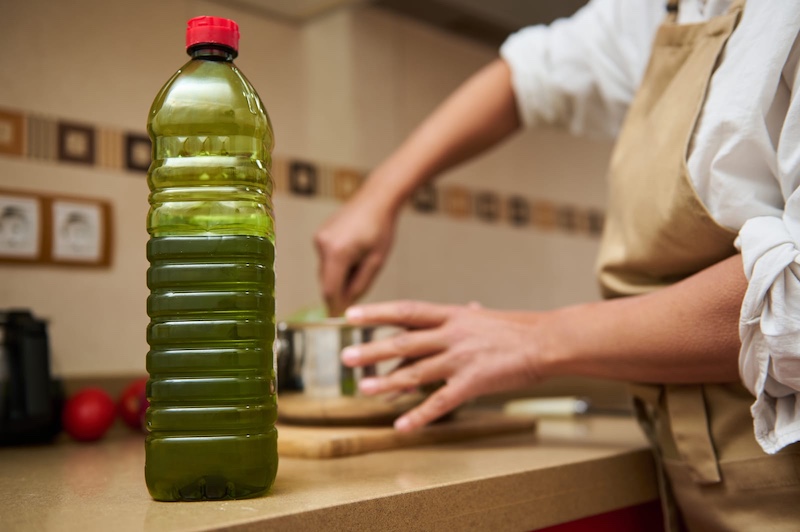Picture this: You’re about to fry up something delicious—maybe crispy fries, golden chicken tenders, or even a batch of homemade tempura. You reach for your trusty bottle of cooking oil, but wait… something seems off. Is that a weird smell? Has the color changed? Is your oil gasp rancid?! Fear not, dear reader, for I am here to help you navigate the treacherous waters of expired oil. Let’s dive into the telltale signs that your cooking oil has gone bad and what you can do about it.
1. The Sniff Test: Does It Smell Funky?
Fresh cooking oil should have a neutral, mild scent—or, in the case of specialty oils like olive or sesame, a pleasant, nutty, or grassy aroma. If your oil smells like old paint, crayons, or something you’d expect to find in a mechanic’s shop rather than your kitchen, it’s probably rancid. This happens when oil oxidizes over time, breaking down into compounds that, quite frankly, your taste buds will not appreciate.
Pro Tip: If your oil smells like your grandmother’s attic or a forgotten gym bag, it’s time to say goodbye.
2. Check the Color: Is It Looking Murky?
Cooking oil is usually clear or lightly golden, depending on the type. If your oil has darkened significantly or turned cloudy when it should be transparent, that’s a red flag. This could mean the oil has started to degrade due to oxidation or contamination. While some unfiltered oils (like extra virgin olive oil) have natural cloudiness, a change in clarity in your standard vegetable or canola oil spells trouble.
Pro Tip: If your oil has changed colors more times than a chameleon, toss it!
3. The Taste Test: A Bitter Goodbye
If you’re feeling brave (or just need solid confirmation), take a tiny taste of the oil. Fresh oil should be mild and pleasant, or even slightly nutty depending on the variety. Bad oil, on the other hand, will taste bitter, soapy, or just plain gross. If your tongue recoils in horror, it’s time to get rid of it.
Pro Tip: The bitterness test doesn’t lie. If it tastes like sadness, don’t use it.
4. Texture Matters: Has It Thickened or Turned Sticky?
When oil starts going bad, it may develop a thick, sticky consistency, especially around the bottle’s rim. If your oil feels more like honey than, well, oil, that’s a clear sign that it’s oxidized beyond salvation. This happens when oil has been exposed to too much air, light, or heat over time.
Pro Tip: If your oil bottle feels like it’s coated in glue, it’s time for an upgrade.
5. Does It Smoke Too Soon?
Each type of oil has a specific smoke point—the temperature at which it starts to break down and produce smoke. If you notice your oil is smoking at a much lower temperature than usual, it could be past its prime. Old oil loses its stability and starts burning quicker, which means not only does your food taste terrible, but you’re also inhaling some unpleasant (and potentially harmful) fumes.
Pro Tip: If your kitchen starts looking like a foggy horror movie scene every time you cook, it’s time to swap that oil.
6. Expiration Dates Matter (But They’re Not Everything)
Most cooking oils have a “best by” date, but that doesn’t mean they immediately turn into toxic sludge the moment the clock strikes midnight. However, if your oil has been sitting on the shelf since the last time flip phones were cool, it’s probably past its prime. Store-bought oils typically last:
- Vegetable & canola oil: 6-12 months after opening
- Olive oil: 12-18 months
- Nut & seed oils (like walnut or flaxseed): 3-6 months (these go bad quickly!)
- Coconut oil: 2 years (the MVP of long-lasting oils!)
Pro Tip: Keep an eye on those dates, but trust your senses first!
How to Store Oil Properly to Extend Its Life
Now that you know how to spot bad oil, let’s talk about keeping it fresh! Follow these tips to get the most mileage out of your favorite cooking oils:
- Store in a cool, dark place – Heat and light speed up oxidation, so keep oil in a pantry rather than next to the stove.
- Use dark or opaque bottles – Light degrades oil, so opt for dark-colored glass or solid containers when possible.
- Keep it sealed tightly – Oxygen is the enemy, so always close the cap securely.
- Refrigerate delicate oils – Nut and seed oils stay fresh longer in the fridge (just let them come to room temp before using).
Final Thoughts: Don’t Let Bad Oil Ruin Good Food
Cooking oil may not have the most dramatic expiration signs—no mold, no fuzz, no neon green glow—but that doesn’t mean it won’t turn against you in sneaky ways. Trust your senses, store it properly, and don’t be afraid to let it go when the time comes. After all, life’s too short for bad oil and ruined recipes!
Now go forth and fry, sauté, and drizzle with confidence. Your taste buds will thank you!
